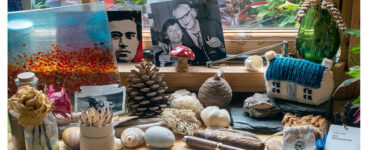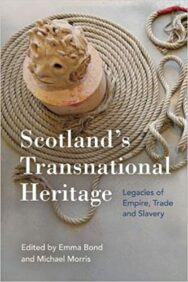“There is no one single national history. National histories are not fixed in any particular time or space. We can always intervene to produce and articulate new understandings of history.”
How do we rethink the way Scotland’s history is told today? How do we tell stories of Scotland’s role within colonialism, particularly in the context of calls to decolonise institutions? These are some of the fundamental questions that Scotland’s Transnational Heritage reckons with. We spoke to editors Emma Bond and Michael Morris to learn more.
Scotland’s Transnational Heritage: Legacies of Empire and Slavery
Edited by Emma Bond and Michael Morris
Published by Edinburgh University Press
What can we expect from Scotland’s Transnational Heritage?
Scotland’s Transnational Heritage aims to offer a new way of reading the legacies of slavery and empire in Scottish heritage sites and museums through adapting a transnational perspective. It also introduces new methodological insights into how to best communicate these transnational histories to public audiences. Seeing heritage histories through a transnational lens allowed our work and that of our contributors to take account of different scales of influence – from the very local to the national and the global – and to emphasize Scotland’s role as an active agent in networks of empire and colonialism.
We wanted the book to be accessible to as wide an audience as possible, so we invited a broad and diverse range of authors to contribute: from artists to academics and museum professionals. We also wanted the book to have a practical slant, and to be of use to people who might be looking for innovative ideas and methods of telling history in engaging ways, so we have included case studies from researchers who use sensory methods, digital storytelling, and various modes of artistic practice to tell the stories of Scotland’s transnational heritage.
What drew you to this topic for exploration?
The book came out of a network that we ran between 2019-2020, which was funded by the Royal Society of Edinburgh and was called “Transnational Scotland: Reconnecting Heritage Stories through Museum Object Collections”. The network involved a number of key museums and heritage sites in Scotland: from the Watt Institution in Greenock to New Lanark, Verdant Works, V&A Dundee and the Fisheries Museum in Anstruther. The grant gave us the chance to build connections with other scholars and practitioners in the field, and to increase our familiarity with museum collections across the country.
This network in turn built on Emma’s previous work in transnational studies and long-standing collaborations with the Watt on projects aimed at re-telling the story of the sugar trade in Greenock, and with Michael’s established expertise in Scottish connections with Transatlantic Slavery. Both editors feel passionate about the need to diversify the stories we tell about Scotland’s role in empire and the legacies of colonialism and slavery that persist to the present day, and the need to diversify the voices we hear telling those stories.
The concept of how we rethink the way Scotland’s history is told, and consider the context of calls to decolonise institutions, is a huge undertaking; how do you approach a project so vast?
It’s important to note that this book is building on ongoing work by multiple individuals and organizations that goes back decades, so this book isn’t by any means the first attempt to try and rethink the way that Scotland’s history is told and to raise awareness of the legacies of empire and slavery that underpin so much of Scotland’s cultural, economic and social heritage. People like Sir Tom Devine, Dr Stephen Mullen, Sir Geoff Palmer, Lisa Williams and Zandra Yeaman have, in various ways, already done much of this groundwork, and their meticulous, informed work has ensured that there is a lot of public interest in these conversations in Scotland.
It’s also important to note that we were not aiming to produce a complete overview of Scottish history from a transnational perspective – such an undertaking would be impossible within the scope of a single volume. What we wanted to put together was a cluster of case studies that would provide a snapshot of ongoing work in the field, with examples of new takes on existing histories (such as the linen trade on the East Coast, or Scottish involvement in the East India Company), and new methods for communicating transnational histories to broad audiences.
We see this very much as an ongoing conversation that still has a long road ahead, and we look forward to people engaging with the book and adding their own perspectives, experiences and practices to that conversation.
How stories and histories are told is ever-evolving; how has the way in which Scotland reckons with its own history changed over time?
The nineteenth century saw a proliferation of museums; and the early twentieth century saw the establishment of the likes of the National Trust for Scotland and the Royal Commission on the Ancient and Historical Monuments of Scotland. In recent decades, the devolved Scottish government has made changes in the management of the nation’s heritage bodies. Such institutions have been shaped by dominant understandings of the way that history is understood and ought to be presented. And these have always been subject to significant public challenge and critique.
For Scotland, of course the question of nation and Scotland’s relationship with the United Kingdom is a key one. The twentieth century saw major challenges along the lines of social class, and gender, with searching critiques to do with how wealth is made and who makes history. All of this has contested and affected how Scotland’s heritage is presented and received.
What we are seeing now is a new wave which emphasises the role of empire. I think it’s important to say that empire has always been an important issue in the preservation and promotion of Scotland’s heritage, but it’s often tended towards the celebratory or sanitised. What we’ve looked to emphasise is a critical perspective which looks to stimulate new ways of telling Scotland’s past and to reflect on new ways of acknowledging the human cost of transnational networks and circulations in terms of slavery, exploitation and empire.
The book outlines new historical examples of how Scottish trades and institutions benefited from the Empire – could you share some examples that people may not be aware of?
The role of textiles comes through strongly in the book. Tuckett and Whatley’s chapter emphasises the growth of the linen industry which is so strongly associated with the East coast of Scotland in the 18th century. But it places that industry in the context of the slave economy as such a high percentage of the exports were sent to the Americas to provide clothing for enslaved people. This industry nurtured the growth of the jute industry in the nineteenth century which relied so heavily on imperial activity associated with the East India Company which employed so many Scots. This connects to Bashabi Fraser’s chapter which addresses the East India Company directly as an armed trading company, and challenges the sanitised memory of the East India Company across contemporary museums.
Indeed, this story which links the ‘west’ and ‘east’ is developed more in relation to ‘Paisley shawls’ manufactured from cotton and with designs owing much to imitation from Kashmir. Re-developments at Paisley Museum are looking to re-contextualise the role of cotton in the town’s boom years in relation to slavery and empire.
Textiles are such a rich imaginative source for transnational studies, both in relation to raw materials and circulations of design. Teleica Kirland’s exhibition Tartan: its Journey Through the African Diaspora tracked global connections between the Scottish Highlands, Chennai, the Caribbean, the Maasai in Kenya and Zulus in South Africa through tartan cloth designs.
Part of the project is offering ways to inspire heritage and museum staff to create new approaches to these histories in Scotland and beyond – who are some examples of those who are already approaching this innovatively to share and inform and how are they doing so?
One of the real pleasures of the network was connecting with some remarkable people who are working both inside and outwith established institutions. Moves are under way at the likes of National Museum of Scotland, Scottish National Portrait Gallery, V&A Dundee to recognise the ways that the institution has benefitted from and perpetuated the inequalities of empire, and what might begin to undo some of that. Artists such as Alberta Whittle and Graham Fagan address this material head on. Whittle’s exhibits for Transparency at the Edinburgh Printmakers in 2019 provided inspiration for the kinds of insights we wanted to emphasise. We also wanted to give space to student activism in the form of Uncover Ed which has played such an important role in addressing the role of universities in relation to empire in recent years.
And there are some really striking projects taking place outdoors! Lisa Williams provides guided Black History Walking Tours of Edinburgh. In Glasgow, Adura Onashile’s Ghosts combined the walking tour format with mobile phone technology through an app which shed new light on the ‘Merchant City’. In Dundee, Mona Bozdog developed a site-specific, multi-media ‘storywalking’ format to communicate the memories of Timex. And Jeni Reid used postcards which combined picturesque photography of Angus with information from slave registers. These postcards were left for people to find in unexpected places, the dissonance of image and text looked to disturb expectations and spark new questions.
Finally, Amy Parent and William Moore provide the Afterword which addresses the repatriation of a pole stolen from First Nations people of Canada and which is now displayed in the National Museum of Scotland. In recent weeks a delegation has visited from Canada to meet with museum staff. We wanted to facilitate this kind of concrete example of transnational heritage which begins to make moves towards justice and repair.
You have both written extensively via your respective roles – are there any topics that you’d be keen to explore next, whether an entirely new project or an offshoot that has arisen throughout your work on this project?
Michael will continue to work in this vein through a project on Jamaican-Scottish radical Robert Wedderburn. Emma is currently completing a new monograph project on museum practices in contemporary literature, which has benefitted enormously from the work she’s done with museums in Scotland.
What do you hope readers take from Scotland’s Transnational Heritage?
I would say that we hope readers will take away the idea that there is no one single national history, and that national histories are not fixed in any particular time or space. We can always intervene to produce and articulate new understandings of history, based on the emergence of new evidence and on contemporary advances in scholarly thought. Also, we’d like for people to join us in thinking that artists, museum professionals and researchers from outside the academic discipline of History can contribute meaningfully to the creation of new historical understandings.
Scotland’s Transnational Heritage: Legacies of Empire and Slavery edited by Emma Bond and Michael Morris is published by Edinburgh University Press, priced £24.99 (pb) and £90 (hb).
ALSO IN THIS ISSUE

 The Banes O’ The Turas
The Banes O’ The Turas
‘An wi yon beamin glow ayont wirds, Hamish fer aye oor lad o pairts bides eternal. ‘

 Never Did The Fire
Never Did The Fire
‘We write books to explain what has happened to us, and it is impossible to translate that experienc …













